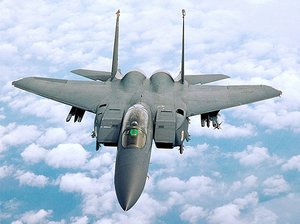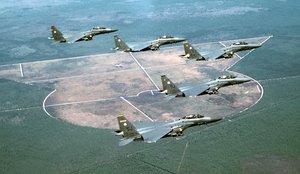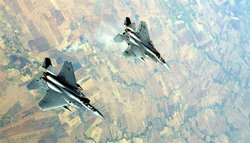F-15 Eagle
|
|
The McDonnell Douglas F-15 Eagle is an American-built, all-weather, extremely maneuverable, tactical fighter designed to gain and maintain air superiority in aerial combat.
| Contents |
Design
The F-15's manuverability is derived from low wing loading (weight to wing area ratio) with a high thrust-to-weight ratio enabling the aircraft to turn tightly without losing airspeed. The weapons and flight control systems are designed so one person can safely and effectively perform air-to-air combat.
A multimission avionics system includes a head-up display, advanced radar, inertial navigation system, flight instruments, ultra high frequency communications, tactical navigation system and Instrument Landing System. It also has an internally mounted, tactical electronic-warfare system, "identification friend or foe" system, electronic countermeasures set and a central digital computer.
The head-up display projects through a combiner, all essential flight information gathered by the integrated avionics system. This display, visible in any light condition, provides the pilot information necessary to track and destroy an enemy aircraft without having to look down at cockpit instruments.
The F-15's versatile pulse-Doppler radar system can look up at high-flying targets and down at low-flying targets without being confused by ground clutter. It can detect and track aircraft and small high-speed targets at distances beyond visual range down to close range, and at altitudes down to treetop level. The radar feeds target information into the central computer for effective weapons delivery. For close-in dogfights, the radar automatically acquires enemy aircraft, and this information is projected on the head-up display. The F-15's electronic warfare system provides both threat warning and automatic countermeasures against selected threats. Because of the advanced electronics deployed on the F-15, the aircraft was given the nickname "Starship" by users.
A variety of air-to-air weaponry can be carried by the F-15. An automated weapon system enables the pilot to perform aerial combat safely and effectively, using the head-up display and the avionics and weapons controls located on the engine throttles or control stick. When the pilot changes from one weapon system to another, visual guidance for the required weapon automatically appears on the head-up display.
The Eagle can be armed with combinations of four different air-to-air weapons: AIM-7F/M Sparrow missiles or AIM-120 AMRAAM advanced medium range air-to-air missiles on its lower fuselage corners, AIM-9L/M Sidewinder or AIM-120 missiles on two pylons under the wings, and an internal 20 mm Gatling gun in the right wing root.
Low-drag, Conformal Fuel Tanks were especially developed for the F-15C and D models. Conformal fuel tanks can be attached to the sides of the engine air intake trunks under each wing and are designed to the same load factors and airspeed limits as the basic aircraft. Each conformal fuel tank contains about 114 cu. ft. (3,200 L) of usable space. These tanks reduce the need for in-flight refueling on global missions and increase time in the combat area. All external stations for munitions remain available with the tanks in use. AIM-7F/M Sparrow missiles, moreover, can be attached to the corners of the conformal fuel tanks. Because the CFTs degrade performance (although not as much as normal external tanks), and cannot be jettisoned in-flight (unlike normal external tanks) air combat F-15s (A/B/C/D) typically fly without them, while the F-15E typically flies with them.
The F-15E Strike Eagle is a two-seat, dual-role, totally integrated fighter for all-weather, air-to-air and deep interdiction missions. The rear cockpit is upgraded to include four multi-purpose CRT displays for aircraft systems and weapons management. The digital, triple-redundant Lear Siegler flight control system permits coupled automatic terrain following, enhanced by a ring-laser gyro inertial navigation system.
For low-altitude, high-speed penetration and precision attack on tactical targets at night or in adverse weather, the F-15E carries a high-resolution APG-70 radar and low-altitude navigation and targeting infrared for night pods.
Service history
The original and largest operator of the F-15 is the United States Air Force.
F-15_vertical_deploy.jpg
The first F-15A flight was made in July 1972, and the first flight of the two-seat F-15B (formerly TF-15A) trainer was made in July 1973. The first Eagle (F-15B) was delivered in November 1974. In January 1976, the first Eagle destined for a combat squadron was delivered.
The single-seat F-15C and two-seat F-15D models entered the Air Force inventory beginning in 1979. These new models have Production Eagle Package (PEP 2000) improvements, including 2,000 lb (900 kg) of additional internal fuel, provision for carrying exterior conformal fuel tanks and increased maximum takeoff weight of up to 68,000 lb (30,600 kg).
The F-15 Multistage Improvement Program was initiated in February 1983, with the first production MSIP F-15C produced in 1985. Improvements included an upgraded central computer; a Programmable Armament Control Set, allowing for advanced versions of the AIM-7, AIM-9, and AIM-120A missiles; and an expanded Tactical Electronic Warfare System that provides improvements to the ALR-56C radar warning receiver and ALQ-135 countermeasure set. The final 43 included a Hughes APG-70 radar.
F-15A and B models were utilized by Israel during the Bekaa Valley operation.
F-15C, D, and E models were deployed to the Persian Gulf in 1991 in support of Operation Desert Storm where they accounted for 36 of the 39 Air Force air-to-air victories. F-15Es were operated mainly at night, hunting SCUD missile launchers and artillery sites using the LANTIRN system.
They have since been deployed to support Operation Southern Watch, the patrolling of the No-Fly Zone in Southern Iraq; Operation Provide Comfort in Turkey; in support of NATO operations in Bosnia, and recent air expeditionary force deployments.
Inventory
The USAF has an Active force of 396 aircraft with a further 126 in the Air National Guard.
Users
The F-15 is also operated by Israel, Japan and Saudi Arabia. A special version of the F-15E, the F-15K has been ordered by South Korea, with final assembly of the first example beginning in June, 2004.
Other Aircraft named F-15
During the Second World War, Northrop built an unarmed version of the P-61 Black Widow called the F-15 Reporter (F under the Army Air Force system in use until the formation of the United States Air Force in 1947 stood for Photo Reconnaissance).
Kill record
As of 2000, the F-15 in all air forces has a combined kill record of 104 kills to zero losses in air combat (a Japanese F-15J shot down another F-15J in 1995 due to an AIM-9 Sidewinder safety malfunction during air-to-air combat training with real weapons).
The majority of these kills have actually been made by Israeli Air Force pilots. A number of Syrian-piloted Russian MiG-21's and several MiG-25, the planes that the F-15 was designed to counter, were shot down in the late 1970's and early 1980's. In the 1982 Invasion of Lebanon, dozens (figures quoted on various websites vary from 80-92) of Syrian MiGs were shot down, including additional MiG-25's. A substantial fraction of these were shot down with F-15's.
Royal Saudi Air Force pilots shot down two F-4 Phantoms flown by the Iranian Air Force in a border skirmish in 1984, and two Iraqi MiGs during the Gulf War.
The balance of the aircraft kills were by the USAF in the Gulf War, mostly by missile fire. Most of the kills were reportedly of aircraft fleeing, rather than actively trying to engage US planes. The F-15 was heavily used in air-to-ground attacks as well as for air superiority.
The F-15E sustained two losses to ground fire in the Gulf War in 1991. One F-15E was lost in the 2003 Invasion of Iraq, probably due to ground fire.
Future
The F-15C/D model is being replaced by the F-22 Raptor. The fate of the F-15E is yet unknown but as the airframes are relatively recent, will likely remain in the U.S. inventory for some years to come.
Specifications (F-15 Eagle)
F-15_takeoff.jpg
General characteristics
- Crew: 1 (A/C), 2 (B/D/E)
- Length: 63.75 ft (19.43 m)
- Wingspan: 42.75 ft (13.03 m)
- Height: 18.625 ft (5.68 m)
- Wing area: 608 ft² (56.5 m²)
- Empty: 28,000 lb (12,700 kg)
- Loaded (C variant): 44,500 lb (20,200 kg)
- Maximum takeoff:
- C/D: 68,000 lb (30,800 kg)
- E: 81,000 lb (36,700 kg)
- Powerplant: Engine types
- F-15E: 2x Pratt & Whitney F100-100 afterburning turbofans, 23,930 lbf (106.4 kN) thrust each
- F-15K: 2x General Electric F110-GE-129 afterburning turbofans, 29,000 lbf (129 kN) thrust each
Performance
- Maximum speed: 1,650 mph (2,660 km/h) (Mach 2.5)
- Range: km ( miles)
- Service ceiling:
- A/B/C/D: 65,000 ft (19,800 m)
- E: 50,000 ft (15,000 m)
- Rate of climb: 50,000 ft/min (15,240 m/min)
- Wing loading: lb/ft² ( kg/m²)
- Thrust/weight:
Armament
- 2 wing and 1 centerline hardpoints for a total of 16,000 lb (7,300 kg) ordinance, including:
- Guns: 1x M61 Vulcan 20 mm Gatling gun with 940 rounds (A/B/C/D), 500 rounds (E)
- Missiles: 4x AIM-7F (upgraded to AMRAAM), 4x AIM-9 Sidewinders on wing plyons, plus a total ordnance load of 16,000 lb (7,300 kg) on two wing stations and one centerline station
- Bombs: The F-15E is capable of carrying every air to ground bomb in the USAF inventory, including free fall nuclear bombs and the 4,500 lb GBU-28 bunker penetration bomb.
Related content
Template:Commons Related development:
Comparable aircraft: MiG-25 - MiG-31 - Su-27
Designation series: F-11 - YF-12 - F-14 - F-15 - F-16 - F-17 - F/A-18
Variants: F-15A - F-15B - F-15C - F-15D - F-15E - F-15K
F-15 in Fiction
F-15 made famous in the hit cartoon The Transformers as the character Starscream and in Challenge of the GoBots as Leader-1. Also, in the movie Air Force One starring Harrison Ford when the Eagles were fighting against the Russian MiG-29s.
See also:
- List of military aircraft of the United States
- List of fighter aircraft
- Comparison of 2000s fighter aircraft
References
- http://www.geocities.com/CapeCanaveral/Hangar/2848/f15.htm
- http://www.airtoaircombat.com/background.asp?id=11&bg=21
- http://www.faqs.org/docs/air/avf15_2.html
|
Lists of Aircraft | Aircraft manufacturers | Aircraft engines | Aircraft engine manufacturers Airports | Airlines | Air forces | Aircraft weapons | Missiles | Timeline of aviation |
de:McDonnell Douglas F-15 fr:Mc Donnell Douglas F-15 Eagle he:F-15 nl:F-15 Eagle pt:F-15 Eagle ja:F-15 (戦闘機) sl:McDonnell Douglas F-15 Eagle fi:F-15 Eagle sv:McDonnell Douglas F-15 Eagle



